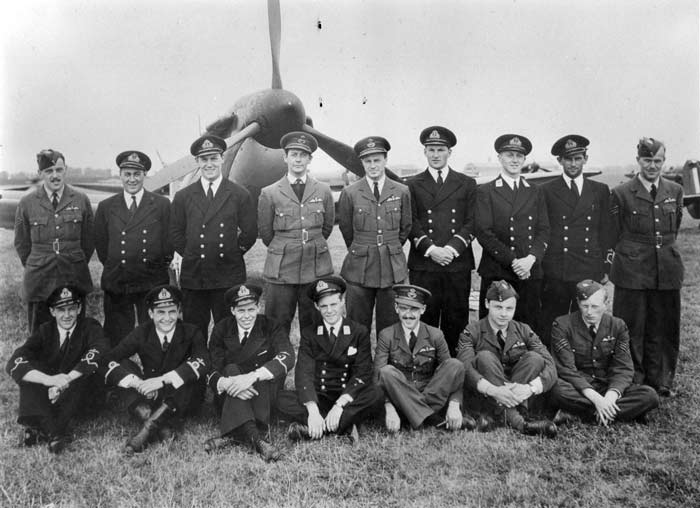The Airmen's Stories - Mid.(FAA) M A Birrell
Maurice Andrew Birrell was born on 23rd April 1921 and joined the Air Branch of the Royal Navy on 1st July 1939, rated as a Midshipman (A). He did his elementary flying training at 14 EFTS Elmdon and went on to 7 FTS Peterborough on 11th December on No. 7 (FAA) Course.
He completed his training on 27th May 1940.
In response to Churchill's request to the Admiralty for pilots, Birrell was one of those attached to the RAF on 15th June 1940.
He arrived at 7 OTU Hawarden on the 17th, converted to Hurricanes and joined 79 Squadron at Biggin Hill on 1st July.

Above: this is Birrell's course at Hawarden, he is seated centre.

When the squadron was sent to Acklington for a rest on 13th July Birrell had flown only one operational sortie, on the 9th, during which he damaged a Me109.
He did not stay with 79 but returned to the Fleet Air Arm on 20th July. He carried out fighter training with 760 Squadron at Eastleigh before joining 804 Squadron at Hatston on 31st August 1940. Birrell was slightly injured on active service on 28th October 1940.
After a short spell with 802 (FAA) Squadron, he returned to 804 when it became a Catapult Fighter Unit in March 1941. Birrell was the first pilot to be catapulted from a CAM ship on 18th May 1941 in Belfast Lough. The rockets misfired, setting off an air raid warning in the city, and his Hurricane touched the water before being able to climb away.
He sailed in the ss Michael E on 28th May 1941, bound for New York. Five days out from Belfast the ship was torpedoed by U-108 on 2nd June in the Central North Atlantic and Birrell was among the survivors picked up after twenty hours in lifeboats.
His next ship was the Ariguani. On 26th August he was shot off in a Fulmar to deal with a Fw200 Condor. He fired one burst before it vanished into cloud. Birrell headed for Northern Ireland and landed on a beach. On enquiry he found that it was neutral Donegal. He took off again and reached Eglinton, almost out of fuel.
In late October 1941 he survived when the Ariguani was torpedoed 300 miles off Lisbon on the 26th.
His subsequent service is currently undocumented but he stayed in the navy postwar and was awarded the DSC (gazetted 3rd October 1952) for service in HMS Glory in Korea.
Birrell retired in 1972 as a Commander and died in October 1990 in Yeovil.
|